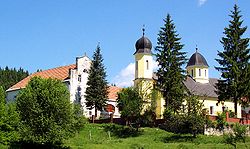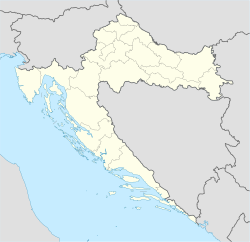Gomirje
Village in Primorje-Gorski Kotar, Croatia From Wikipedia, the free encyclopedia
Gomirje is a settlement in north-western Croatia, situated at the far east of the mountainous region of Gorski kotar in the Primorje-Gorski Kotar County. It is part of the Vrbovsko municipality. The population is 343 (as of the 2011 census). [4][5]
Gomirje
Gojmerje, Gomerje | |
|---|---|
Village | |
 | |
 | |
| Coordinates: 45°20′10″N 15°07′01″E | |
| Country | Croatia |
| County | Primorje-Gorski Kotar |
| Municipality | Vrbovsko |
| Area | |
• Total | 6.7 km2 (2.6 sq mi) |
| Elevation | 418 m (1,371 ft) |
| Population (2021)[3] | |
• Total | 255 |
| • Density | 38/km2 (99/sq mi) |
| Time zone | UTC+1 (CET) |
| • Summer (DST) | UTC+2 (CEST) |
History
Summarize
Perspective
The remains of an old fortification exist on the Stražnik hill.[6]: 306
On 17 September 1602, the županijski sudac Bernardo Severšić issued from Bosiljevo a judgement on a case between the Frankapan family members Juraj, Nikola and Vuk on the one hand ant the Vlachs of Gomirje on the other.[7]: 5
A brick fortification was built in Gomirje itself by the Sečen[a] family for defence against the Turks. Documents relating to this were said to have been preserved in the castles of Bosiljevo and Severin.[6]: 306
Kingdom of Yugoslavia
In 1933, Chetnik formations were organised on the territory of Srpske Moravice, Gomirje and Lička Jesenica. They had a minor political influence until 1941 when a large number of them were killed in the first wave of liquidations.[8]: 346
WWII
1941
In May 1941, the Ustaša government began targeting known and suspected JRZ members with arrests. The prominent JRZ members in Gomirje at the time were Vlado Mrvoš, Petar Musulin, Bogdan Mamula and Miloš Trbović.[8]: 352
In late May, the Ustaše arrested a number of villagers from Gomirje were and imprisoned them in the Ogulin castle, transferred on 6 June to the Danica concentration camp, and finally the Jadovno concentration camp.[8]: 355
A 2 July was issued order for all Velike župe, including that of Modruš (with seat in Ogulin), to make room for 2500 Slovenes each, who were to occupy the homes of 2500 Serbs, to be deported to the GMS, prioritising businessmen and merchants. Gomirje was to accommodate 250 Slovenes. As of mid-July, there were not enough empty Serb homes to accommodate the exchange. The kotarski načelnik complained that Gomirje had been confiscatd by the state and that the monastery was going to be used as a livestock station, emphasising the need to "first deport all Serbs, and then import the Slovenes" (Croatian: prvo iseliti sve Srbe, a potom naseliti Slovence).[8]: 365
It has been claimed that the plunder of the monastery was done on the order of Ogulin priest Ivan Mikan,[9]: 9 On 9 June 1941, according to the memory of the sole surviving Gomirje monk, father Nektarije Dazgić, the Ustaše arrived by surprise from Ogulin in a truck, besieged the monastery, drove the monks into their cells and questioned them about money and the keys to the monastery coffers. After beating them, they transported them to Ogulin. Any remaining monks of Gomirje were arrested in late June and early July. In early July, the hegumen and four monks had not yet been sent away. As of a 15 July document, all Orthodox priests from Gomirje had been sent to concentration camps. At Danica, Dazgić recalled seeing almost the entire ecclesiastical court of Plaški, and a total of more than 30 priests.[8]: 359, 360
In the context of deportations of families to the GMS through Sisak concentration camp during the planned Slovene-Serb ethnic exchange, the općinsko poglavarstvo of Gomirje wrote that all men of Gomirje from age 16 up had fled into the forests in fear of the Ustaše, so that the općina did not know which houses had been emptied and which were only temporarily empty.[8]: 367
On 30 July, many Serbs from Ogulin and the surrounding villages were arrested at the market in Ogulin. The second uncle of Milka Bunjevac, a Vučinić with a prominent job at the railway station, was to be arrested that day, but he was warned by an Ustaša that he should flee "wherever he knows" (Croatian: kamo god zna) because that night he would be arrested. Vučinić then boarded a train from Ogulin to Gomirje, arriving at his sister's house around midnight and then fleeing to the GMS two or three days later.[8]: 361
1945
In 1945, Gomirje native lieutenant Mihajlo Barbulović,[b] commander of the SDS in Kamenica and later Chief of Staff of the Mountain Guard of the JVuO, went missing in Bosnia.[11]: 27 Barbulović was married to Bosiljka née Bosanac, who was to be interrogated by the Gestapo and, on the order of Svetozar Nećak, held as a hostage. But she had already escaped to safety. A file on Barbulović is kept at the Historical Archive of Belgrade, and a letter of his to Valjevo okružni načelnik Dragomir Lukić from the "free Serbian mountains" (Serbian: слободних српских планина) survives.[10]
Federal
The volunteer fire department DVD Gomirje was founded on 29 January 1982, and is today part of the VZ grada Vrbovsko.[12] Its current commander is Mihajlo Kosanović.[13]
Recent
Gomirje was hit by the 2014 Dinaric ice storm. From 31 January to 2 February 2014, while S and SW geostrophic wind dominated,[14] freezing rain fell on Gorski Kotar, glazing the entire region. It wrecked roofs, power lines an forests, causing power loss for about 14,000 households households in Gorski Kotar, or about 80% of its population. It took about 10 days to restore essential infrastructure to the region, and within months electricity was back in most of its former range, but at a cost of about 84.4 million HRK to HEP. At the time it was the largest peacetime damage since its Secession from Yugoslavia, even without counting the forestry losses. The Šumarija Gomirje fared well relative to western forestry branches, losing mainly diseased and very poorly anchored trees.[15] Clearing blocked forestry roads and forest paths would take years, and thanks to the declining population some were never cleared.[16]
On 19 December 2020 at 18:54 the ŽVOC Rijeka received a call about a structure fire in the former DIP sawmill on Jove Stojanovića Brice 23 where 110 round bales had caught on fire. It was put out at 4:40 on the 20th by DVD Gomirje, DVD "Željezničar" Moravice, DVD Vrbovsko and JVP Ogulin.[17]
On 22 March 2024 at 1:49 the ŽVOC Rijeka received a call about a fire inside the local pellet plant, encompassing 1,200 square metres (13,000 sq ft). It was localised at 3:10 by DVD Gomirje, DVD Vrbovsko, DVD "Željezničar" Moravice, DVD Lukovdol and JVP Ogulin.[18]
Demographics
Summarize
Perspective
Note:Includes Ljubošina and Musulini in 1857 and 1869 and partly in 1880. Considered a dio naselja from 1890. From 1910 to 1931, part of the population was counted under Ponikve, općina Ogulin. In 2001, Kamensko and Majer were separated. From 1857 to 1880 and in 1981 and 1991 it includes the population of Majer. Sources:Croatian Bureau of Statistics publications
In 1835, Gomirje belonged to Ogulin. There were 92 houses, with a population of 1017. Its residents were mostly Orthodox, but 29 were Catholic.[6]: 305
In 1890, the obćina of Gomirje (court at Gomirje), with an area of 79 square kilometres (31 sq mi), belonged to the kotar of Ogulin (Ogulin court and electoral district) in the županija of Modruš-Rieka (Ogulin high court and financial board). There were 355 houses[21] (384 in 1910),[22] with a population of 2522 (the lowest in Ogulin kotar): 1251 male and 1271 female;[23] 2003 in 1910.[22] The majority were Croatian or Serbian speakers, but 6 spoke Slovene, 6 Hungarian and 2 German. The majority were Eastern Orthodox, but 202 were Catholic and 4 were Jewish. Its 11 villages and 9 hamlets were divided for taxation purposes into 2 porezne obćine, under the Ogulin office.[21]: iv, v [23]: xxviii, xxix
In 1910, the entire općina had no resident soldiers. Militarily, Gomirj fell under the 26th Landwehr Infantry Regiment and 26th Landsturm Infantry Brigade, both at Karlovac.[22]: iv, v
Besides Gomirje itself, settlements encompassed by Gomirje općina in 1890 were: Đurić Brdo (14 houses, 88 people), Kolostaj (10 houses, 93 people), Kovačevići (2 houses, 26 people), Luke (12 houses, 66 people), Majer, Musulinski Kraj, Polovine (14 houses, 87 people), Ranići (5 houses, 38 people), Zelići (2 houses, 18 people), Kosanović Brdo (14 houses, 121 people), Ljubošina, Rabatić Poljana, Brezova Poljana, Trnova Poljana, Hambarište, Stubica, Tuk, Vujnović Selo. Of those, the following were considered hamlets of Gomirje: Đurić Brdo, . Gomirje proper had 49 houses, 423 people, a post office, a telegraph, and a school attended by all hamlets but Kovačevići (which attended the school in Vrbovsko). With hamlets, Gomirje had 155 houses, 1087 people.[24]: 37
Further reading
- Kraljevski zemaljski statistički ured (1903). Političko i sudbeno razdieljenje i Repertorij prebivališta Kraljevina Hrvatske i Slavonije po stanju od 1. travnja 1903. Zagreb: Kraljevska hrvatsko-slavonsko-dalmatinska zemaljska vlada, 🖶 Kraljevska zemaljska tiskara.
- Kraljevski zemaljski statistički ured (May 1913). "Repertorij prebivališta po županijama, upravnim kotarima, gradovima, upravnim i poreznim općinama". Političko i sudbeno razdjeljenje i Repertorij prebivališta Kraljevina Hrvatske i Slavonije po stanju od 1. siječnja 1913. Zagreb: Kraljevska hrvatsko-slavonsko-dalmatinska zemaljska vlada, 🖶 Kraljevska zemaljska tiskara. pp. 1–126. Page 22.
Religion
In 1835, Gomirje Monastery administered Drežnica, Moravica, Vrbovsko, Ponikve, Marindol and Bojanci.[6]: 306
Governance
As of its foundation on 3 March 2008, it is the seat of a local committee encompassing Musulini, Majer and Kamensko.[25]
Presidents of local committee:
- Nikola Mamula (2008)[26]
- Rade Mrvoš (2009)[27]
- Đurđica Polovina (2013,[28] 2017)[29]
- Nemanja Musulin (2021),[30] Independent
When the Vlachs of Gomirje requested a confirmation of their Uskok rights throughout the territory they inhabited in 1605, they listed its boundaries as stretching from Mali Klek – Ustanke (the confluence of the Vitunjčica and the Dobra) – Vrbica – Kamensko – Vrbovsko – Plešivica – Mošenski – Bilek – "Potschovodo" – Topolovica – Okrugljik – Radigojna – Gornji Lazi.[31]
In 2020, the option of dividing Vrbovsko into 4 municipalities (Croatian: općine) was being considered, one being Gomirje.[32]
Culture
As of 2009, Gomirje hosts an annual Cvjetni korzo.[33] As a part of the festival, a competition was held to decide on the house with the most beautiful garden beginning in 2013 for the first time since 1966.[34]: 3
Sports
The "Gorski Kotar Bike Tour", held annually since 2012,[33] sometimes goes through Gomirje, such as in the third leg for 2022.[35]
Infrastructure
Gomirje has a post office,[36]: 24 an infirmary,[36][37] an Udaljeni pretplatnički stupanj (UPS).[36]: 24
The water storage unit in Kosanovići, with a capacity of 100 cubic metres (3,500 cu ft) at an elevation of 528.3 metres (1,733 ft), uses on the Draškovac pumping station at 356.62 metres (1,170.0 ft), with 9.5 l/s flow. It is responsible for Gomirje.[38]
Sights
- Gomirje Monastery - the westernmost Orthodox monastery
Notable natives and residents
- Lazar Mamula (1795-1878) - baron, general in the general in Austro-Hungarian army and governor of Dalmatia
- Bogdan Mamula (1918-2002) - antifascist, partisan and People's Hero of Yugoslavia
- Desanka Đorđević (1927-2011) - dancer and folk dance choreographer in the National Ensemble of Folk Dances and Songs of Serbia, Ensemble "Kolo"
Notes
References
Further reading
Wikiwand - on
Seamless Wikipedia browsing. On steroids.

